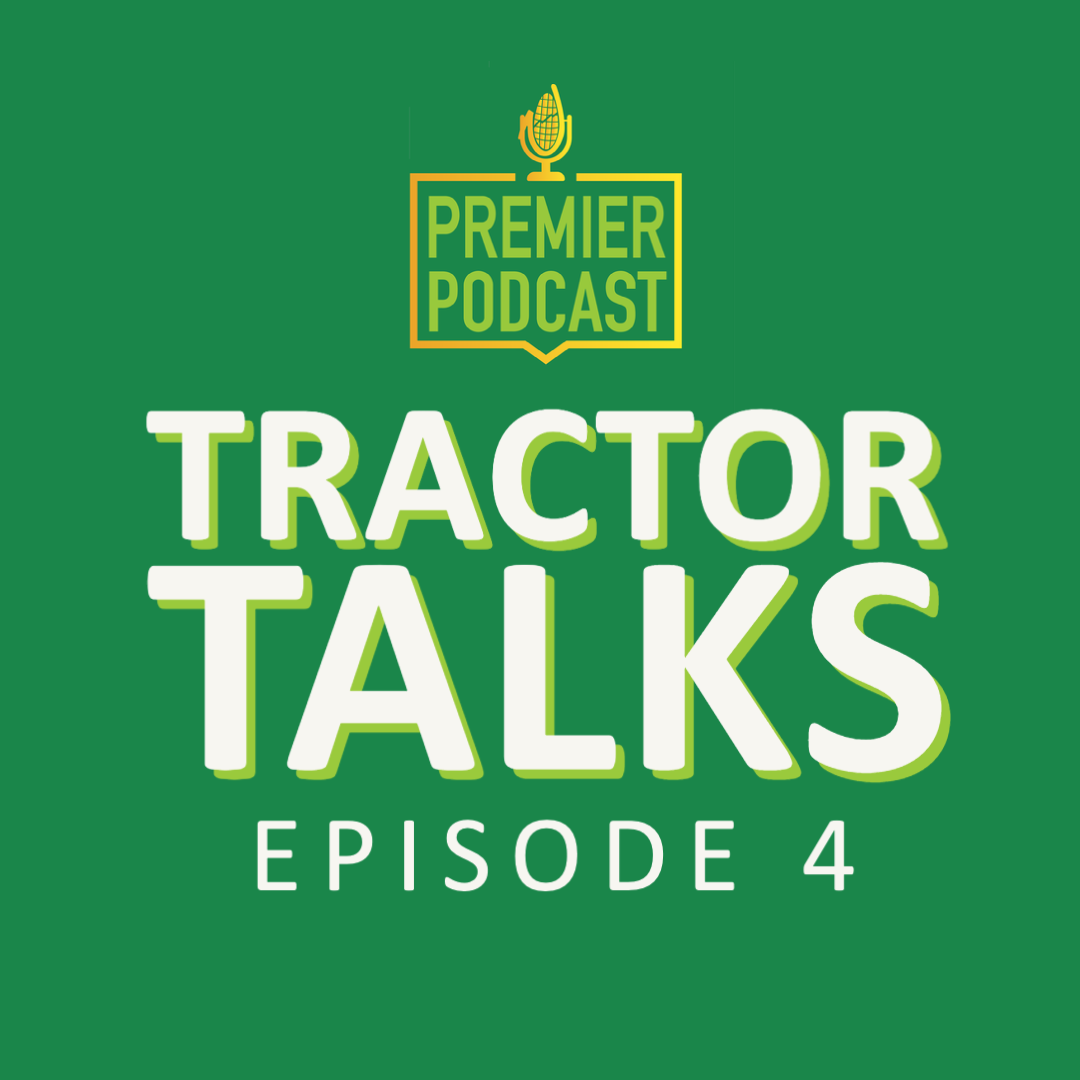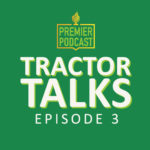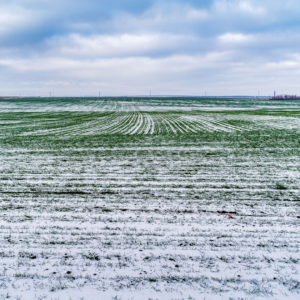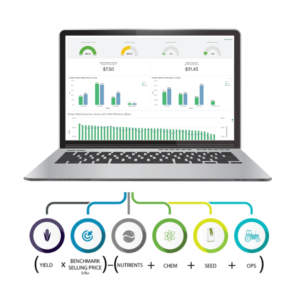
Tractor Talks is a mini series here on the Premier Podcast where we join growers in their tractor cabs during the spring and hear candid thoughts on technology and precision ag.
This series is hosted by Katie McWhirter, Manager of Training and Development at Premier Crop Systems.
If you are enjoying the show, tweet us using #PremierPodcast.
JOE: It’ll work, plus it’ll give me more confidence and allow me to have a partner and make some of those decisions without worrying so much. The group I’m with is going — I’m going to do things a little different. I’m going to do some more future stuff, which I always did, but I’m going to do them differently. And I’ve learned a lot already just by working with them. So I’m excited about that. It’ll take some of the stress, and I can focus more on growing a crop instead of how I’m going to get rid of it.
KATIE MCWHIRTER: Oh, I love it. One grower I was talking with last Friday — and his dad and my dad are about the same age — and it was: ‘We’re going to do it all ourselves.’ So it just sounds like this next generation is: ‘I’m going to find good partners, good people on my team, and I’m going to do what I’m good at.’ But I’m okay saying: ‘You know what? This would really help make my life easier and have somebody else on my team to be able to help market, or if it’s a spray or your agronomist or whatnot.’
JOE: To go off of that, a lot of the same thoughts went into when I decided to work with Premier Crop. It’s the same exact thing as my marketing is. I’ve got all these maps. I’ve been saving them. Don’t know what to do with them. I could work with a seed corn company, and they could make me maps, and they probably would work. I could work with another group that does similar things, but Premier is independent, and I know they’re not selling anything. I trust everybody I work with. It takes one more layer away from making some of those decisions. It’s just an independent, unbiased opinion. They don’t care how much seed I put in the ground. They don’t care how much fertilizer I buy. They just want me to be successful. I do like that. Like the marketing, it’s given me confidence that when I write a big check for fertilizer, it’s going where it needs to be, and I’m not spending more than what we talked about and what we think is necessary.
RENEE HANSEN: Welcome to the Premier Podcast miniseries ‘Tractor Talks.’ This is a series comprised of talks in the tractor cab with one of Premier Crop’s advisors, Katie McWhirter, and growers as they are planting this spring. Listen to what their real, honest thoughts are when it comes to nutrient management, technology and precision ag.
KATIE MCWHIRTER: I’m talking to whom?
JOE: Joe.
KATIE MCWHIRTER: Cool, Joe. So you’ve been farming for how long?
JOE: Since 2003.
KATIE MCWHIRTER: 2003, and did you always want to be a farmer?
JOE: Yes, but not for sure when I was going to start. After college, I was planning to maybe do something else for five years. But the way things worked out, I jumped right in after college, and it was the best thing I ever did.
KATIE MCWHIRTER: Why do you say that?
JOE: Well, timing was big because it was just the right time to get in. Didn’t know it at the time, but if I would’ve waited five years, I would have missed a lot of opportunities. Then, I just made up my mind that I should go farm now. And if it doesn’t work out, I could always go do something else instead of reverse. So that’s just kind of how I ended up farming.
KATIE MCWHIRTER: Cool. So you farm by yourself? With family?
JOE: Started out partnered up with my dad. We farmed together. Then, he slowly worked into retirement, and this is the first year he’s officially retired, as far as farm ground and stuff. I took over, rented from him what he farmed, and he did it gradual. Every year, one or two farms, he’d give up. This is the first year he didn’t plant a crop or didn’t — I guess, yeah. He said he wasn’t going to plant this year. And by God, he stuck to it. He didn’t get in the planter once.
KATIE MCWHIRTER: Wow. So what’s that transition been like for you?
JOE: It’s been good because he’s been very helpful, and he still helps when we’re busy. Every fall, he’s there every day. In the spring, he’s running seed and getting parts and keeping everything moving. But it’s been a slow transition. So it’s not all at once. That would have been really tough, to just say: ‘Hey, I’m done. Have fun.’ I knew. You could see it coming. We had kind of a five-year plan, and it worked out really well. He still likes to be around and likes to help. But day to day, when we’re not in the field, I might see him. I might not.
KATIE MCWHIRTER: That’s awesome. So you’ve been farming. What’s changed in that timeframe for you?
JOE: Mostly, probably, technology. A lot has changed, from how we map things to how we do seed recs to fertilizer. And we were kind of into that a little bit when we started. When I started, he was already doing yield maps. But at the time, we just had maps. Didn’t do anything with them. Now, we’re actually starting to use them and make some decisions with them. But it’s good that we’ve got all those because we can still go back and use them. And I knew that the whole time, but how we use technology has probably changed the most. Planters have really changed. We don’t variable-rate our beans yet. It’s on the list. It’s one of the next things I’ve got to do, get there. But the corn, I have been for a couple of years now. I haven’t done it long enough to know if it’s really being effective, but the way you think about it, it’s got to be. It’s just almost got to be effective because you’re putting the seed where it needs to be instead of just blanket-rating the whole farm.
KATIE MCWHIRTER: So, before, you were variable-rating your corn, and I love to ask growers this. Do you think that you were farming for average? Or seeding for average? Or seeding for…
JOE: Yes because I knew that some of my — 32-and-a-half. 32,500 across the board, every farm, every acre, unless my dealer would say: ‘No, this one needs 34.’ Then, I would. Or: ‘This one, it’s a flex. It doesn’t need it. You can plant 31-and-a-half on a tough farm.’ Okay, I’ll do that. But I hit the average. 32-and-a-half was enough, but I knew I wasn’t wasting that much on the poorer-side hills and the knobs. So it’s just a happy medium. And I was okay with it because sometimes we don’t know, when we plant, if it’s going to rain or if it’s going to be really wet. We thrive in the wet years in our hills because we have natural drainage, and we lose yield on some of the clay-side hills. But everywhere else, the ridges and the better ground, it makes up for it a long way.
KATIE MCWHIRTER: So why do you think soybeans is next on your list? Some people stay away from that, but you’re saying it’s next on your list. So why do you think so?
JOE: I just think there’s enough yield data now that lower pops are better, and it may even be more than we think. And last year was probably an exception because it was dry, but everything I looked at last year, the lower pops won. It almost seemed like, even on the tougher ground, where you’re supposed to use higher pops, the lower pops were better. So I don’t know. Maybe I just lower my pop and don’t variable-rate. I’m not going to trade planters just to do it, but when I do trade, the next one will have it. That’s kind of where I’ve been with that, and that’s why I still don’t have it. My planter worked again this year, so I don’t know. Maybe I’ll run it again next year, but it just needs more and more off-season maintenance each year, it seems like.
KATIE MCWHIRTER: What made your decision to — I guess you said your dad was mapping already, and I don’t know. What was the first piece of technology that you brought in when you came back to farming? I don’t know if it was row shutoffs or what, but what made you decide to start making those changes?
JOE: We could see the money was there. One of the easiest decisions to go to technology was row shutoffs on our planter. And it was just a no-brainer in our hills and our point rows and contouring and terraces. We could see the payback, just automatic: 10%, maybe more, of seed savings and, then, in corn. Plus you gain yield where you’re not overlapping, and we even did it the same year on our bean planter. And part of it was seed savings, but part of it was just the simplicity of planting. You don’t have to run the half switch all the time. You just can plant and focus on your job instead of running the half shutoff.
KATIE MCWHIRTER: It’s kind of funny. I was talking with a grower on Friday, and he said, with all the technology and the tractor’s driving itself, he’s got time to watch the monitors, make sure things aren’t plugging and that sort of thing. In turn, as I’ve ridden with farmers in the last week, they’re so calm. You’re smiling right now. But, really, it’s not as stressful, to just be able to watch things and not be so worried about what could be going wrong back, behind, because you have the technology that’s telling you if things are wrong. So I don’t know if you can elaborate on that.
JOE: Oh my gosh, you hit it right on the head. Before 2017, I had a 16-row Deere planter with airbags. In the years we had compaction from anhydrous in the fall, the planter, I just could not get the outside couple of rows in the ground. And I fought it, and I could have added weight. Should have. But then, the next year, the ground was softer, and I got away with it. But eventually, I went to a hydraulic downforce planter and ended up going to 24-row. And apparently, there’s more weight on that bar because I don’t have any trouble with it coming out of the ground. But those years, prior to hydraulic downforce, I had very little confidence in the job I was doing, planting corn. But it was all I had, and I was doing the best I could with what I had. But every time I’d fold up and leave a farm, I knew I left some on the table, and the monitor wasn’t as good. But now, the monitor tells me if I’m skipping. Or if I’ve got a bad downforce, I slow down a little bit. Or if there are any problems at all with a meter, you just know, and it’s beeping. And sure enough, there’s a problem. You can find it. And one of the neatest things is it’s got 27 holes in the disc, and I don’t know the exact percentage. But if you get, like, 96.3, or whatever the number is, consistently on one row, you just know what happened. You’ve got a piece of corn stuck in one of those. Every round it makes, that’s why your percentage is 1/27th off. You can just tell, before you even get out of the planter, what happened.
KATIE MCWHIRTER: What do you think is next in the industry, as far as precision or technology? This one seems to stump people, and I know it.
JOE: Yeah, I think — well, what I did this year, I don’t know if it’s next for everybody, but it was a first for me this year. We variable-rated all of our anhydrous, and that’s really not anything new, but I’d never done it. And I think that’s along the same lines as variable-rating your corn. You put it where you need it. Or we use a stabilizer on our anhydrous but not on every acre. My agronomist, who I get this stuff from, he has, over the years, kind of figured out what soils are more prone to have leaching or problems where we maybe lose a little bit of anhydrous. So he, him and his son — his son does a lot of the mapping stuff — they will map out and make a variable-rate application for your stabilizer. So they’re variable-rating my nitrogen amount, plus they have an on-off switch that’s automatic while they’re putting anhydrous on. And it turns on and turns off where they think we need it. And that’s a variable rate also. So if they’re putting more on, then they’re putting a little more stabilizer on too. I think I was the guinea pig for that this year. Because, with Premier Crop and their system, they made it work together. I think it took a little doing, but they made it work.
KATIE MCWHIRTER: That’s awesome. That’s really awesome because you bring up a good point, just regulations and environmentally and getting a grasp on nitrogen. I mean, you say it’s not new to variable-rate nitrogen. I would say a lot of growers don’t tackle variable-rate nitrogen because it’s so uncertain, and they don’t want to. I always say nitrogen and seed are sexy to talk about. So we always think: ‘More nitrogen. More.’ But on the flip side, we don’t know what’s out there, and we don’t want to be short. But environmentally, we’re probably going to be regulated at some point. For somebody like you, to already start to collect that data and have, be trialing out to see what works, what doesn’t. Hopefully, you’re going to be ahead of the game when somebody tells you how much that you can use.
JOE: And we do get by. And right now, going to the regulations and stuff, I will probably have to make a change. Because I do 100 percent of my nitrogen with anhydrous. I get a little from my dry application, depending on what products we use. But for the most part, it’s all fall anhydrous unless, like a year or two ago, it was done in the spring because there just weren’t enough good days for the applicators to get it done. And we got along fine, but I prefer it in the fall. We tend to get away. I don’t know how or why, but we use less nitrogen than what Iowa State recommends, and it seems to be working. And I don’t know if that’s the case for everybody, but you hear some of these crazy corn-on-corn numbers where, yeah, I know you need more nitrogen. Or, even, you get into better ground where the yield potential is there. They’ll just pour it too, and I’m putting 150 pounds of nitrogen on. For the last, probably, five years, that’s my number. And now, of course, this year, it was variable-rated, so we went down to like 135 up to 170. We didn’t go crazy either side, but the average was still right in that 150 to 152. Couple of years ago — and I’m in some tougher ground. It will produce, but two-and-a-quarter is the best average I’ve ever had across the whole farm. So that’s kind of what we’re up against in a lot of years. I plan for 185-190 when I’m doing the budgets and things. If we get over 200, that’s great. But we’re not surprised in a year like last year. It was really dry, and we still had 160. I was okay with that. I was expecting worse. But 150 pounds is enough for two-and-a-quarter-bushel corn. Where’d it come from? So I’ll keep putting on less.
KATIE MCWHIRTER: I love it because, to actually look at the data tag, to know your nitrogen efficiency, and you bring up a great point about planning. Do you have a plan in place for all of your inputs before going into the season, or what’s that look like?
JOE: After a few years, you kind of get the calendar routine going, where, with my fall anhydrous, I know sometime in as early as June some years — but, a lot of times, it’s some time in July — he’ll call and say: ‘Hey, I got prices for anhydrous. This is what it is now. Whatever you think, if you want to book it, great. In 20 days, I’m going to have to order more, and it’s going to be higher. I know it’s going to be $25 a ton higher.’ Then, I’ll go ahead and usually book it. So that’s the first step, usually. Then, shortly after that, we start talking seed, corn and beans. And there for a while, like 15 years ago, we were buying corn in August. And I was a dealer at the time, and I didn’t even feel comfortable. But it was more of a thing. Go talk to them. Get some numbers down. If you want to switch out your hybrids, fine. But at least get them signed up so you kind of got it locked in. But now, it’s been late October — late November even — before I have to pay for the first discount. And that’s a lot more manageable because you can get at least part way through harvest and kind of see what you’re dealing with. But for the most part, I know what I’m going to do anyway.
It’s just a matter of tweaking a few hybrids or maybe trying some new ones. Then, December timeframe, a lot of times, I’ll try to get my chemicals figured out and get the plan for that, which means you’ve got to decide if you’re going in list. If you’re going to dicamba, what you’re going to do. And these last couple of years, that’s been a big decision that we didn’t have to make before. But I went ahead and went with dicamba beans again 100 percent this year, and — knock on wood — haven’t had any troubles. So we’ll see. Hopefully, we get some good spray days, and I can have another good year of that. But I think a lot of it comes down to just being smart and not pushing it. And I spray my own. So it’s manageable. In four days, three to four days, I can spray all the beans, and maybe less if the weather’s right. But you could just pick your days a little better than maybe we used to with just straight Roundup, where you really weren’t going to hurt a lot unless the wind was really blowing. But now, you might have to spray half a farm and then go back three days later, or even two weeks later, if the wind doesn’t change and finish it up. But I think if you respect the wind and your neighbors a little bit, you can make it work.
KATIE MCWHIRTER: Do you typically stick with your plan? Or, in season, how might plans change?
JOE: Typically, my plans stick pretty much true. This year, I was planning to plant my later corn first, right around home here, and just get it in the ground so it could mature and be dryer at harvest. But, then, we got a nice window, and I changed my mind there. I started away from home. Planted one farm at home to make sure everything worked. Then, I went south and made my way around and did some tougher farms that I didn’t want to get wet in case it did rain too much. Well, what’s too much this year? I didn’t want to plant in wet holes. So I planted at the tougher farms and the farms that I knew were going to ethanol or into an air bin first this year, which is usually not how I do it. So that was a change. Then, I’ve still got three farms left to go, but they’re later maturity, and they’ll go through the dryer. So if they’re a little wetter, we’ll just wait on them and throw some heat to it. But otherwise, I usually don’t make a lot of changes. I usually have a pretty good plan going in, but I don’t change a lot from year to year either. So I kind of find something I like and sort of stick with it. Yeah, it’s hard to say. Spraying is probably where I changed the most because I always plan and buy and try to schedule two passes on corn and two passes on beans. But last year was probably the first year that I sprayed both crops twice. Everything.
A lot of years, I’ll get part of my corn sprayed the first time, and then the last third is coming up. It’s pretty clean. I’ll just wait another two weeks or three weeks. It’ll be V3 before — I was going to spray at V5 anyway. So I think I’ll just jump out there at V2 and hit it once. So far, that’s worked, but it’s not the plan. Long-term, you wouldn’t want to do every acre that way. But on certain farms, it does work. But you’ve got to have the right weather because, then again, if it rains for two weeks when you’re trying to spray that pass and you start getting too many weeds, you start having trouble killing stuff. And I’ve even done it with some dicamba beans. I try to spray them when they are an inch tall, or so. I wait until they grow because the fields are pretty clean. I’ve been waiting and kind of doing a different approach than a lot of people, but I’ll spray when the beans have emerged or leafed out a little bit. Then, I’ll come back with just some straight Roundup and residual and maybe some stuff for volunteer corn there in mid-June and hit them again. I get that dicamba out there when the beans are growing, and I feel like maybe there are more weeds exposed. And I’ll kill more of what’s going to be a problem down the road, rather than using that in my pre. Then, you don’t spray again until June, and you can’t use dicamba then. So that’s kind of how I’ve gone with it, and it keeps working. So I keep doing it.
KATIE MCWHIRTER: Good. What would you say is your biggest struggle?
JOE: Oh, hard to say. The biggest struggle? Marketing is hard. These last couple of years — and it’s this way always — but it’s hard to know. You never know when you’re doing the right thing. So my approach has been: sell to where you’re comfortable. You’re not going to be right all the time. You’re not going to be wrong all the time. You’ve got to just know that. And once you make a sale, move on and worry about the rest. Because if you don’t, it’s going to beat you up every single day, looking back. But if you look back, what I try to tell myself is that day, that was the right decision. That’s what I felt that day. A lot can change, and then how do you know? This year was a perfect example. Things changed marketing. A lot of people were wrong, and I was one of them. But I wasn’t wrong on everything. I did have some corn to sell, and so you space it out. But marketing is a challenge because it’s not black and white. You pick your corn. Yeah, you could pick the wrong hybrid, but it’s probably still going to work. Which day to plant? Who knows? But once you’re planting, you just keep planting, and away you go. You kind of take your mind off making the right decision there, but the marketing is a whole-year thing. You can’t forget about it because you can focus on planting. You can focus on harvest; you can focus on getting your fertilizer plan ready.
But marketing is always one of those things that’s in the back of your mind or closer to the front some days. That’s probably the biggest challenge, and I’ve been doing it myself without an advisor. I get an email or two, but I make the decisions myself. Until about three months ago, two months ago, I signed on with an advisor. And I was hesitant because there is a sizable fee with it. But I was getting to the point where I wanted some help. So I thought: I’ll just try this. And if they’re as good as I think they can be, then it’ll work. Plus it’ll give me more confidence and allow me to have a partner and make some of those decisions without worrying so much. The group I’m with is going — I’m going to do things a little different. I’m going to do some more future stuff, which I always did, but I’m going to do them differently. And I’ve learned a lot already just by working with them. So I’m excited about that. It’ll take some of the stress, and I can focus more on growing a crop instead of how I’m going to get rid of it.
KATIE MCWHIRTER: Oh, I love it. One grower I was talking with last Friday — and his dad and my dad are about the same age — and it was: ‘We’re going to do it all ourselves.’ So it just sounds like this next generation is: ‘I’m going to find good partners, good people on my team, and I’m going to do what I’m good at.’ But I’m okay saying: ‘You know what? This would really help make my life easier and have somebody else on my team to be able to help market, or if it’s a spray or your agronomist or whatnot.’
JOE: To go off of that, a lot of the same thoughts went into when I decided to work with Premier Crop. It’s the same exact thing as my marketing is. I’ve got all these maps. I’ve been saving them. Don’t know what to do with them. I could work with a seed corn company, and they could make me maps, and they probably would work. I could work with another group that does similar things, but Premier is independent, and I know they’re not selling anything. I trust everybody I work with. It takes one more layer away from making some of those decisions. It’s just an independent, unbiased opinion. They don’t care how much seed I put in the ground. They don’t care how much fertilizer I buy. They just want me to be successful. I do like that. Like the marketing, it’s given me confidence that when I write a big check for fertilizer, it’s going where it needs to be, and I’m not spending more than what we talked about and what we think is necessary.
KATIE MCWHIRTER: You’re not unnecessarily — that stress is off your plate. And the time and whatnot, obviously, with three active kids. Yeah, so it made your life a little easier.
JOE: Oh, yeah. And it is fun to sit down and look at the — oh, what’s it called when they compare the different farmers?
KATIE MCWHIRTER: Your benchmark and your dashboards. Yep.
JOE: Benchmarking! That was really interesting to look at. In some places, there could be improvement. But in some places, it shows you: ‘Hey, this is actually working.’ So I was really curious to see where that would come in. Yeah, it’s neat to see. You kind of know the areas you need to focus on a little more than others, and then it reassures you. Yeah, you still pay the money to see it. But in some places, you don’t make any changes because you’re already doing things as good as you can or pretty close anyway.
KATIE MCWHIRTER: Cool. Oh my goodness, Joe. What else? You thought this would be hard. I don’t know. I’m, like, out of questions. You just have been rambling. I love it.
JOE: There’s a lot of neat stuff, though, from technology, and I used to get nervous about it and not focus on it at all. And I still don’t have to that much because I got help, whether it’s Dakota now helping me or Ruth in the past. And it’s so simple. They say: ‘Hey, are you done with harvest?’ Yep, just got done yesterday. ‘Okay, I’ll be over tomorrow to get your maps. I’ll get them right off there. If you’re not home, where’s the combine sitting?’ Then, they take them and then email me back the yield maps, and boom. Then, they might say: ‘Hey, we’re going to come over and load up some planter maps for you.’ Okay. I don’t do anything. I just hit the right button when I’m planting, and I got my map. It’s just simple.
KATIE MCWHIRTER: Good.
JOE: Simpler than I thought it would be.
KATIE MCWHIRTER: That’s good.
JOE: I didn’t know how much prep work and how much I’d have to be there and understand, but it hasn’t really changed anything that way. They make it simple so you can understand it. User-friendly.
KATIE MCWHIRTER: Good. That’s what I love to hear because that technology does work. I always laugh, and I always throw my dad. I don’t want to throw him under the bus. If I get my dad to use this technology, I can get anybody to use it, right? He’s that older generation, but it does work. But there’s that hesitation. Is it going to work, or is it going to slow me down? I was riding with one 70-year-old grower last week, and he said: ‘I just know.’ He goes: ‘Technology’s great when it’s working. But when it doesn’t, and I’m not planting, I think about those 10 acres I could have planted.’ Yep, I get it. But, man, it does make things a lot easier.
JOE: Yeah, you fight it sometimes, where, like you said, you got a weigh pan on a row not working. Well, if I didn’t have this technology, I could be planting. But it’s not too hard for me to say: No, take 20 minutes, or even an hour, and go get the right part because that hour is nothing when you know you did it right because of technology.
RENEE HANSEN: Thanks for listening to the Premier Podcast, where everything agronomic is economic. Please subscribe, rate and review this podcast so we can continue to provide the best precision ag and analytic results for you. And to learn more about Premier Crop, visit our blog at premiercrop.com





